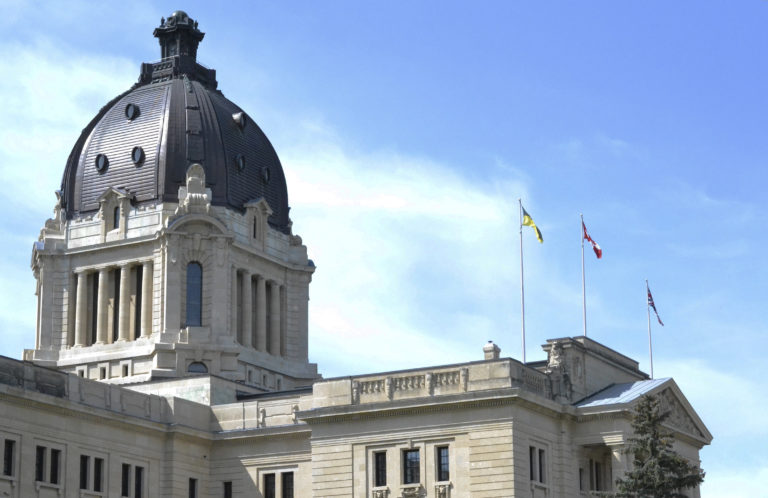
The provincial government reported 60 new COVID-19 cases on Wednesday, the highest number of new cases in a single day since the start of the pandemic.
The majority of those cases are tied to Hutterite communities in the southern part of the province, with 43 of them linked to a single community in the Rural Municipality of Lawtonia southeast of Swift Current. There are currently 17 Hutterite communities with active cases in the southwest and west-central regions.
Premier Scott Moe said the cases were detected following aggressive testing and contact tracing in Hutterite communities around the province. He warned residents in other areas that they could see similar increases as testing continues.
“For the most part, we have had very, very good cooperation with the Hutterian Safety Council, and with community leaders and residents in following (COVID-19) guidelines, and following them very closely,” Moe told reporters during a media update Wednesday afternoon. “However, there have been a few isolated reports of individuals who have not been following these guidelines and they have travelled outside of their communities for non-essential reasons, and even when they may not be feeling well.
“We are in the process of speaking to all of the leaders and all of the Hutterite communities where there is a significant number of cases, and we are working with these local leaders to enact restrictions on all non-essential travel in and out of their communities.”
Moe said local travel would be limited to a small number of designated individuals. Others will not be allowed to leave, even if it’s just to visit another Hutterite community.
Dr. Saqib Shahab, the province’s chief medical health officer, said they are working closely with health officials in Alberta and Manitoba to track the virus’ spread among Hutterite communities. The primary areas of concern are southwest Saskatchewan and southeast Alberta.
He said there are indications that some of the earliest cases were asymptomatic, where symptoms are so mild the patient doesn’t even notice them.
“There may have been some initial asymptomatic infections due to attendance at a search and rescue mission, or a funeral early on, maybe in the middle of June,” Shahab explained. “There have, obviously, been other events and funerals where, again, nobody really wants to go when they’re ill and expose others, but asymptomatic transmission is recognized. The way we interact, that’s the real concern.”
Moe said efforts to curb COVID-19 outbreaks in northern Saskatchewan were largely successful, and the government plans to use the same strategy to stop the virus’ spread in the south. That will include the use of roadblocks, which were criticized by some northern leaders due to the disrespectful attitude of some government checkpoint staff.
Moe said they would be reaching out to Hutterite community leaders to make sure the policies were properly implemented. He also said many communities were implementing restrictions on their own initiative.
“They are very understanding of the threat that COVID-19 brings to their community,” Moe said. “They are very understanding of the measures that they have taken and need to take to make sure we can contain this virus.
“The communal living in our Hutterite colonies, it’s a positive environment for the spread of COVID-19. There is a lot of effort that has to be taken at the local level, and we’re confident that the local leaders are making that effort.”
Both Moe and Shahab urged Saskatchewan residents to avoid stigmatizing communities with a high transmission rate. They said it’s difficult to eliminate the virus if individuals, organizations, businesses or municipalities are wary of public discrimination.
Testing numbers had dropped around the province to the point where some clinics were only open two or three days a week. Shahab said that will change going forward as the province starts to ramp up testing in preparation for the fall cold and flu season. Nearly 85,000 tests have been performed since the start of the pandemic, including 1,200 tests on Tuesday.
“The testing capacity is there,” he said. “Access to testing has been a bit of a challenge in terms of some wait times because of increased testing. That’s been addressed, but I think isolating when you are unwell, seeking testing at the first sign of COVID symptoms, and then a case (contact) investigation will be the only way we are able to control this.”
Hutterite communities have reported at least one active case in the RMs of Auverge, Biggar, Carmichael, Eagle Creek, Grandview, Harris, Kindersley, Lawtonia, Maple Creek, Newcombe, Purdue, Pleasant Valley, Prairiedale, Saskatchewan Landing, St. Andrews, Tramping Lake and Webb.
Of the 60 cases reported on Wednesday, 48 were linked to Hutterite communities in the southwest and west-central parts of the province. One new case was reported in the north, and two more in the far north. The rest were in Saskatoon or the central parts of the province.
The province reported 12 more recoveries, bringing the total number of active cases to 190. There are five active cases in the north and 8 actives cases in the far north.
COVID-19 testing is now available to anyone who requests it, regardless of whether they have symptoms or not. Referrals for testing are available by contacting HealthLine 811. General inquiries may be directed to COVID19@health.gov.sk.ca.
